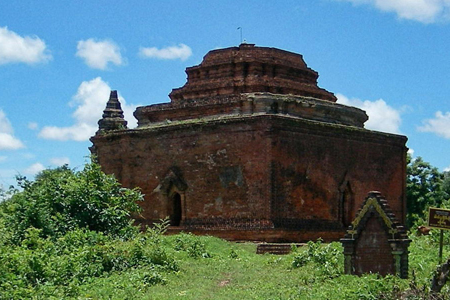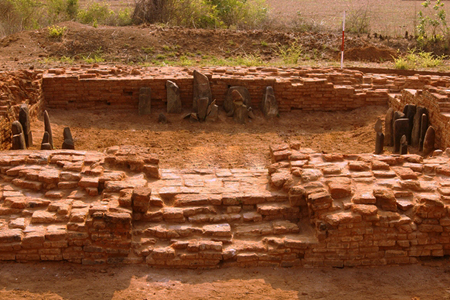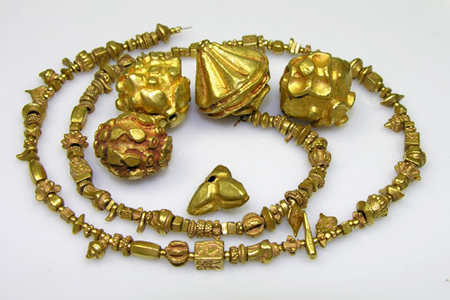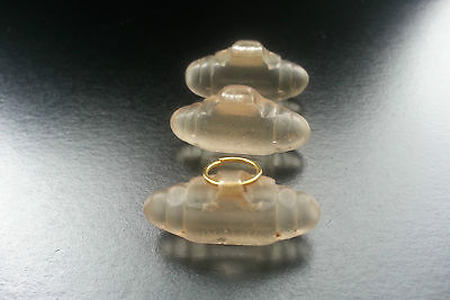Another significant Pyu site to explore in your trip to Myanmar, Halin (or Halingyi-Great Halin), lies about 11 miles south-east of Shwebo in Upper Myanmar. It is reached by road from Shwebo crossing Moksogyon railway-station on the Mandalay-Shwebo line. One passes through irrigated rice-fields on the way but finds himself in a dry scrubland as he approaches the ancient site. There is a group of villages with numerous small modem pagodas to the south of the old fortified city. This locality is noted for hot saline springs.

The antiquity of this city is indeed exaggerated by tradition which asserts that it was founded several thousand years ago by a refugee prince from India descended from Mahasamata, the first fabled ruler of Majjhimadesa, that is India. It is believed that the last king, 799th in succession, was a Pyu. Owing to his misdeed a rain of ashes and molten matter poured down heavily and buried the city completely. Perhaps this legend of a disastrous calamity was fabricated to account for the almost barren and desolated site we see today. It is surprising that such a renowned city is depleted with visible ruins of either religious or secular character, thus presenting a glaring contrast to Sri Ksetra.
However, material evidence of Pyu culture lying buried for centuries has been unearthed to convince us that Halin was once the seat of Pyu culture. The site was superficially explored in 1904-05 and few test excavations were made in 1929-30. The results were by no means disappointing. The earliest discovery is that a small stone slab inscribed in an old script later found to resemble the urn inscriptions of Sri Ksetra and deciphered to be Pyu language. Each of the two Pyu lines is followed by a few interlinear characters in Brahmi. It is an epitaph marking the site of the tomb (or bones?) of one Honourable Ru-ba. It was found to the south of the southeastern comer of the city and was removed to the Bagan Museum. In 1929-30 a second inscription engraved on a hard sandstone slab was found a few hundred feet to the southeast of the first one. There are eight lines of Pyu without any interlinear Brahmi. The name, probably of a queen, Sri Jatrajiku, is readable. The third inscription is illegible. It appears between two panels of a sculptured stone slab the upper portion of which is badly damaged. It bore a large seated figure with the right hand resting on the right thigh. As the head and body are missing it is difficult to identify the figure. The lower panel contains some fifty figures of seated worshippers in three rows. Some wear headdresses and some have coiled hair on their heads.

The villagers often came by objects of antiquarian interest such as gold, silver and bronze objects, ornaments, etc. but these were usually lost through melting down for the sake of metal. Of particular interest among the chance, finds are symbolical coins, some of which could be retrieved owing to frequent discoveries. They are similar to those found at Sri Ksetra and are definitely characteristic of Pyu culture. The only variance on Halin coins is the symbol of the rising sun on the obverse instead of the bhaddapitha emblem as on Sri Ksetra coins.
Systematic excavations at Halin from 1962 to 1967 have shed further light on the cultural complex of the ancient site. The brick-walled city is in the form of a rectangle roughly 2 miles long and one mile wide. As in Beikthano and the inner citadel of Sri Ksetra the north-south axis of the fort plan is slightly inclined to the west. The walls have crumbled down and the debris was strewn about almost at ground level. Traces of a moat are seen on all sides except the south. Most of the excavated sites had to be covered up again as the remains of structures are lower than the ground level. There were originally twelve gateways of which three were exposed in the course of recent excavations. The fort walls curve inwards at the entrances, thus forming two parallel arms which flank the long passage leading to the interior of the city. This feature, as well as the rounded comers of the rectangular fort wall, resembles the layout of the gateways and comers of Beikthano city.

The types of structural remains within the city also show distinctive parallels to those at Beikthano. No round stupas are to be found. The exposed structures consist of square or rectangular buildings with a quadrangular projection on one side in a few instances. Earthen funerary urns are found buried both within and outside the structures. As objects of religious character are altogether absent the structures are deemed to be built solely for the purpose of disposing of the funerary urns. At site No. 9 was exposed the brick walls, at the foundation level, of a large rectangular hall originally provided with 84 wooden pillars to support the roof or superstructure. The posts which lie in four parallel rows within the walls were completely burnt down and could be traced only by the charred stumps a few inches high. Situated near the so-called palace site this structure might have served as an assembly hall as the one at Beikthano mound No. 9.
In 1964 a huge inscribed stone slab was discovered about two furlongs north of the palace site. The inscription contains six and a half lines of Pyu in South Indian script datable to about 8th or 9th century. Each of the full lines measures 53 inches and there are some Brahmi letters between them. The inscription begins with the salutation ‘ Siddham ’ and each of the proper names Sri Trivigrama and Va : ma occur twice, but owing to the scant knowledge we possess of the Pyu language the contents of the inscription still remain unknown. However, from the script and the readable names, it may be presumed that this inscription records a certain event associated with the vikrama dynasty or the Varmans of Sri Ksetra. This inscription and another illegible one also in Pyu are preserved in the inscription shed in Halin village where the sculptured slab is also installed.
Though Buddha statues and clay votive tablets are totally absent this site is notably rich in such small finds as decorated sherds and beads of semiprecious stones, the designs, and workmanship of which exhibit unmistakable affinity with those from Sri Ksetra. A few gold rings, two gold pendants, two gold beads, one round and one barrel-shaped, and several tiny disc beads of gold were found at different ritual structures. Iron nails, knife blades, arrow-heads and sockets for doors are recovered in abundance. Of particular interest among the iron objects found outside the gateways are scores of caltrops with four spikes any point of which inevitably protrudes upward when thrown on the ground. These were used to impede the hostile infantry or cavalry advancing towards the city. Among the utensils of domestic use are three bronze mirrors with long tenons workmanship of which exhibit unmistakable affinity with those from Sri Ksetra. A few to fix into handles of wood, ivory or other material. These are badly damaged due to oxidation.

About a score of symbolical coins was recovered by excavation. The Halin type with the rising sun symbol predominates. A variant type with a conch within the Srivatsa symbol is also found. This type is very rare and only a few specimens were discovered at Sri Ksetra. Some of the contemporary Arakanese coins also bear the conch figure.
Very useful antiquity as collaborative evidence in dating the site is a small oval flat piece of agate inscribed with the word Daya-danam in South Indian characters of the 5th century. The name apparently denotes a donor and the object is probably meant as a signet stone to be set in a metal ring. Many such pieces similarly inscribed with Pali words were discovered at an ancient site, Oc-eo in the Hinduised state of Funan in Indo-China and incidentally one of those bear the identical name as this found at Halin.
From the foregoing, it is evident that Halin, like Beikthano, possesses all the characteristics of Pyu culture with the exception of round stupas and large stone images and metal statues as we find in Sri Ksetra. It shows that though Halin is contemporaneous with Sri Ksetra the Buddhist sect at the latter city which accepted the image-worship did not influence Halin in the least. Another diverting factor which prevailed at Halin is the discovery of numerous stretched skeletons at one site together with funerary urns. It indicates that the burial of corporeal remains in a common way was in vogue parallel to the practice of cremation and urn burial.
It is noticeable that most of the structures where wood was used were destroyed by fire. The wooden gates at the entrances to the city were also burnt. Probably a great conflagration either by enemy action or by local accident had razed the city once and for all. By radiocarbon analysis of the charcoal specimens from the excavated sites the wooden gates from two gateways could be determined to belong to the 2nd-3rd century, and the assembly hall datable to the 6th century.
